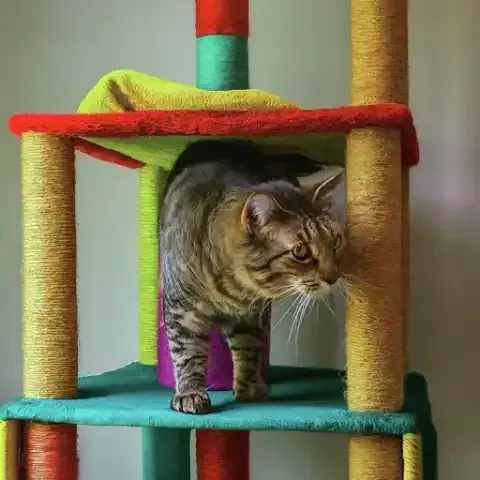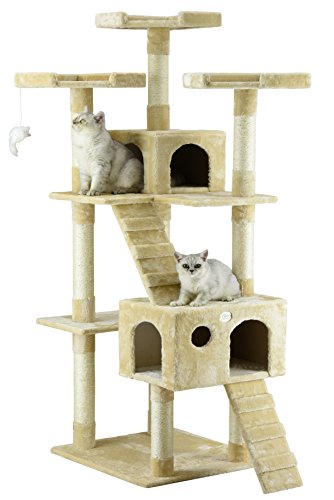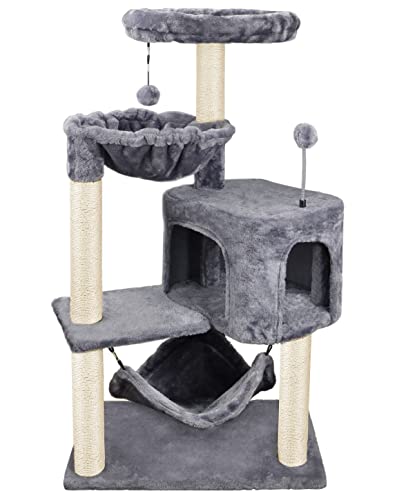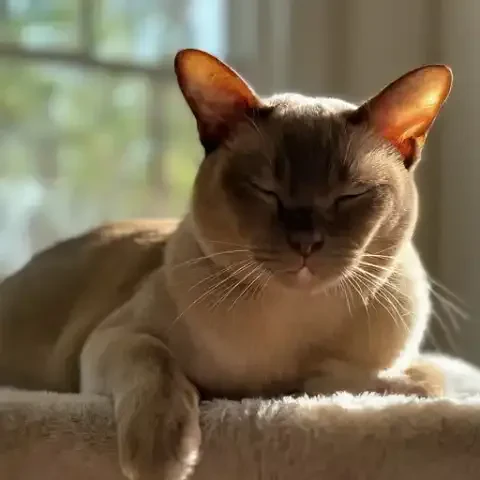Introduction
Owning a cat comes with a myriad of joys and responsibilities, not the least of which is ensuring your feline friend has a stimulating and safe environment to thrive in. Cat trees, also known as cat condos or cat towers, play a crucial role in providing indoor cats with opportunities for exercise, mental stimulation, and a sense of security.
In this comprehensive guide, we'll delve into the world of cat trees, exploring why they're essential for indoor cats and how to choose the perfect one for your furry companion. Whether you're a first-time cat owner or a seasoned feline aficionado, understanding the significance of a well-chosen cat tree can make a world of difference in your cat's quality of life.
Throughout this guide, we'll discuss the natural instincts and behaviors of cats, the various types of cat trees available, key features to consider when selecting one, budgeting tips, reviews and recommendations, as well as maintenance and care tips to keep your cat tree in optimal condition.
By the end of this guide, you'll be equipped with the knowledge and insights necessary to make an informed decision and provide your beloved cat with the perfect cat tree tailored to their needs and preferences. Let's embark on this journey together to create the ultimate haven for your furry friend.
Understanding Your Cat's Needs
Exploring cats' natural instincts and behaviors
Cats are innately curious and active creatures with a strong desire to climb, scratch, perch, and hide. Understanding these natural instincts is crucial for providing an environment that meets their needs. Cats have a territorial nature and often seek out vertical spaces to survey their surroundings, escape perceived threats, and establish a sense of security. By recognizing and accommodating these instincts, you can create a space where your cat feels comfortable and fulfilled.
Discussing the significance of vertical space for cats
Vertical space is essential for cats as it allows them to express their natural behaviors and maintain their physical and mental well-being. Cat trees provide valuable vertical territory where cats can climb, jump, and perch, mimicking the experience of being in trees in the wild. Vertical space also helps reduce stress and conflicts in multi-cat households by offering cats opportunities to claim their own territory and avoid confrontations.
Identifying specific needs based on your cat's age, size, and temperament
Every cat is unique, and their preferences for cat trees may vary based on factors such as age, size, and temperament. Kittens, for example, may require smaller and less complex structures with plenty of opportunities for exploration and play. Senior cats may benefit from lower platforms and easy accessibility. Additionally, considering your cat's temperament, such as whether they prefer to climb, scratch, or hide, can help tailor your choice of cat tree to suit their individual needs. By understanding your cat's specific requirements, you can select a cat tree that aligns with their preferences and enhances their overall quality of life.
Types of Cat Trees
Floor-to-ceiling cat trees
Floor-to-ceiling cat trees are tall structures that utilize tension rods or brackets to extend from the floor to the ceiling, maximizing vertical space. These cat trees often feature multiple platforms, perches, and hiding spots at various heights, providing ample opportunities for climbing and exploration. They are ideal for households with limited floor space and offer a vertical playground for cats to enjoy.
Wall-mounted cat trees
Wall-mounted cat trees are designed to be attached directly to walls, making them a space-saving option for smaller rooms or apartments. These cat trees typically consist of shelves, platforms, and climbing surfaces that are secured to the wall at different heights. Wall-mounted cat trees offer cats the chance to climb and perch while also serving as functional decor pieces.
Modular cat trees
Modular cat trees are customizable structures that allow owners to mix and match individual components to create a cat tree tailored to their space and their cat's preferences. These cat trees often feature interchangeable platforms, scratching posts, and hiding spots that can be rearranged to provide new experiences for cats. Modular cat trees offer versatility and adaptability, making them suitable for households with evolving needs.
Window-mounted cat trees
Window-mounted cat trees attach to windowsills or glass surfaces, offering cats a prime vantage point to observe the outside world while basking in the sunlight. These cat trees typically feature perches or hammocks that are secured to the window with suction cups or brackets. Window-mounted cat trees are perfect for indoor cats who enjoy birdwatching or soaking up the sun's rays.
Freestanding cat trees
Freestanding cat trees are standalone structures that do not require mounting to walls or ceilings. These cat trees often come in a variety of shapes and sizes, ranging from simple scratching posts to elaborate multi-level towers. Freestanding cat trees offer stability and mobility, allowing owners to place them in any room of the house without the need for installation.
Combination cat trees
Combination cat trees combine multiple features, such as scratching posts, perches, tunnels, and hiding spots, into one cohesive structure. These cat trees provide cats with a diverse range of activities and experiences, catering to various preferences and behaviors. Combination cat trees are versatile and space-efficient, making them an excellent choice for households with multiple cats or limited space.
Key Features to Consider
Stability and durability
The stability and durability of a cat tree are paramount for ensuring your cat's safety and longevity of the structure. Look for cat trees constructed from sturdy materials such as solid wood or high-quality engineered wood. Additionally, ensure that the base of the cat tree is wide and stable enough to prevent tipping or wobbling, especially if you have larger or more active cats.
Materials
Consider the materials used in the construction of the cat tree, as they can impact its durability and appeal to your cat. Common materials include carpet, sisal rope, faux fur, and wood. Carpeted surfaces provide comfortable lounging areas and promote scratching, while sisal rope offers an ideal texture for cats to sharpen their claws. Opt for materials that are non-toxic and easy to clean for the health and hygiene of your cat.
Height and size
The height and size of the cat tree should be proportionate to your cat's size and the available space in your home. Taller cat trees with multiple levels and platforms are suitable for active cats who enjoy climbing and perching, while smaller cat trees may be preferable for older or less mobile cats. Consider the dimensions of the cat tree in relation to the room where it will be placed to ensure it fits comfortably without overwhelming the space.
Number and variety of platforms, perches, and hideaways
Choose a cat tree that offers a variety of platforms, perches, and hideaways to cater to your cat's preferences for lounging, climbing, and hiding. Look for cat trees with spacious platforms for comfortable resting, elevated perches for observing their surroundings, and enclosed hideaways for privacy and security. Providing a diverse range of options ensures that your cat will find the cat tree appealing and engaging.
Additional features
Consider any additional features or accessories that may enhance your cat's enjoyment of the cat tree. Features such as built-in toys, hammocks, hanging ropes, and scratching posts can provide additional stimulation and entertainment for your cat. Evaluate your cat's interests and behaviors to determine which features are most likely to appeal to them and incorporate them into your choice of cat tree.
Ease of assembly and maintenance
Choose a cat tree that is easy to assemble and maintain to streamline the process of setting it up and keeping it clean. Look for cat trees with clear assembly instructions and minimal hardware for hassle-free construction. Additionally, opt for cat trees with removable and washable components to simplify cleaning and maintenance tasks, such as removing hair and debris or spot cleaning spills and stains. A cat tree that is easy to assemble and maintain will ensure that both you and your cat can enjoy it with minimal effort and inconvenience.
Budgeting for a Cat Tree
Understanding the price range of cat trees
Cat trees come in a wide range of prices, from budget-friendly options to high-end models with premium features. The price of a cat tree is typically influenced by factors such as size, materials, construction quality, and additional features. Basic cat trees may be available for as little as $30-$50, while more elaborate or larger cat trees can range from $100-$300 or more. Consider your budget and the features that are most important to you and your cat when evaluating the price range of cat trees.
Evaluating the cost versus quality relationship
When budgeting for a cat tree, it's essential to consider the relationship between cost and quality. While it may be tempting to opt for the cheapest option available, investing in a higher-quality cat tree can pay off in the long run in terms of durability, stability, and overall satisfaction. Look for cat trees constructed from sturdy materials such as solid wood or durable engineered wood, with secure attachments and stable bases to ensure longevity and safety for your cat.
Tips for finding affordable options without compromising quality
If you're working within a limited budget, there are several strategies you can use to find affordable cat trees without sacrificing quality. Consider shopping during sales events or taking advantage of discounts and promotions offered by pet supply retailers. Additionally, explore online marketplaces and classified ads for gently used cat trees at discounted prices. Keep an eye out for clearance or discontinued models that may be available at a reduced cost. By being resourceful and strategic in your search, you can find a high-quality cat tree that meets your budgetary constraints and provides your cat with a safe and enjoyable environment.
Reviews and Recommendations
Highlighting popular cat tree brands and models
Researching popular cat tree brands and models can provide valuable insights into the features, quality, and overall satisfaction of different options. Look for reviews and recommendations from reputable sources, such as pet product review websites, forums, and online retailers. Pay attention to feedback from other cat owners regarding factors such as stability, durability, ease of assembly, and how well the cat tree meets their cats' needs and preferences.
Sharing user experiences and testimonials
User experiences and testimonials offer firsthand accounts of how well a cat tree performs in real-life settings. Seek out reviews and testimonials from other cat owners who have purchased and used the cat trees you're considering. Pay attention to feedback regarding factors such as construction quality, stability, ease of assembly, and how well the cat tree holds up over time. Hearing from other cat owners can provide valuable insights and help you make an informed decision.
Providing expert insights and recommendations based on specific needs and preferences
Consider seeking advice from veterinarians, animal behaviorists, or experienced cat owners who can offer expert insights and recommendations based on your specific needs and preferences. They can provide guidance on factors such as choosing the right size and type of cat tree for your cat, as well as tips for encouraging your cat to use the cat tree effectively. Expert recommendations can help you narrow down your options and select a cat tree that best meets your cat's unique requirements.
By researching reviews and recommendations, considering user experiences and testimonials, and seeking expert insights, you can make a well-informed decision when choosing a cat tree for your furry friend. Taking the time to explore different options and gather information will ensure that you select a cat tree that enhances your cat's environment and promotes their physical and mental well-being.
Maintenance and Care Tips
Cleaning and sanitizing your cat tree
Regular cleaning and sanitizing of your cat tree are essential for maintaining a healthy and hygienic environment for your cat. Use a vacuum or lint roller to remove loose hair, debris, and dirt from the surfaces of the cat tree. For deeper cleaning, wipe down the surfaces with a mild detergent or pet-safe cleaner and warm water. Pay special attention to areas where your cat frequently rests or scratches, as these can harbor bacteria and odors. Allow the cat tree to air dry thoroughly before allowing your cat to use it again.
Regular inspections for wear and tear
Periodically inspect your cat tree for signs of wear and tear, such as loose screws, frayed ropes, or damaged platforms. Tighten any loose hardware and replace any worn or damaged components promptly to ensure the stability and safety of the cat tree. Keep an eye out for signs of excessive wear, such as sagging platforms or wobbly posts, which may indicate that it's time to replace the cat tree altogether.
Tips for encouraging your cat to use the tree
If your cat is hesitant to use the cat tree, there are several strategies you can try to encourage them to explore and enjoy it. Place treats or toys on the platforms or perches to entice your cat to climb and investigate. Sprinkle catnip on the scratching posts to attract your cat and encourage them to scratch. You can also use interactive play sessions to encourage your cat to use the cat tree, using wand toys or laser pointers to engage their natural instincts to chase and pounce.
Troubleshooting common issues with cat trees
If your cat is exhibiting undesirable behaviors such as scratching furniture or avoiding the cat tree, there are several troubleshooting techniques you can try. Provide alternative scratching surfaces such as cardboard scratchers or sisal mats to redirect your cat's scratching behavior away from furniture. Experiment with different locations for the cat tree to find a spot that your cat finds appealing and comfortable. If necessary, consult with a veterinarian or animal behaviorist for additional guidance on addressing behavioral issues related to the cat tree.
By implementing these maintenance and care tips, you can ensure that your cat tree remains clean, safe, and enjoyable for your cat to use. Regular cleaning and inspections, along with strategies for encouraging your cat to use the tree, will help promote your cat's health and well-being while extending the lifespan of the cat tree.
Summary
Choosing the perfect cat tree is a vital decision for cat owners looking to provide their feline companions with a stimulating and safe indoor environment. This comprehensive guide has explored various aspects of selecting the ideal cat tree, from understanding your cat's natural instincts and behaviors to evaluating different types of cat trees and key features to consider.
Understanding your cat's needs, including their age, size, and temperament, is crucial for selecting a cat tree that aligns with their preferences. Exploring the different types of cat trees, such as floor-to-ceiling, wall-mounted, and freestanding options, allows you to choose a structure that fits your space and your cat's activities.
Key features to consider when choosing a cat tree include stability, materials, height, size, and the number and variety of platforms and hiding spots. Budgeting for a cat tree involves considering the price range, evaluating the cost versus quality relationship, and finding affordable options without compromising on durability and features.
Reviews, recommendations, and expert insights provide valuable guidance in selecting a cat tree that meets your cat's needs and preferences. Finally, maintaining and caring for your cat tree involves regular cleaning, inspections for wear and tear, and troubleshooting common issues to ensure its longevity and your cat's enjoyment.
By following the advice outlined in this guide, cat owners can make an informed decision when choosing the perfect cat tree for their furry friends, creating a stimulating and comfortable environment that promotes their cats' physical and mental well-being.







